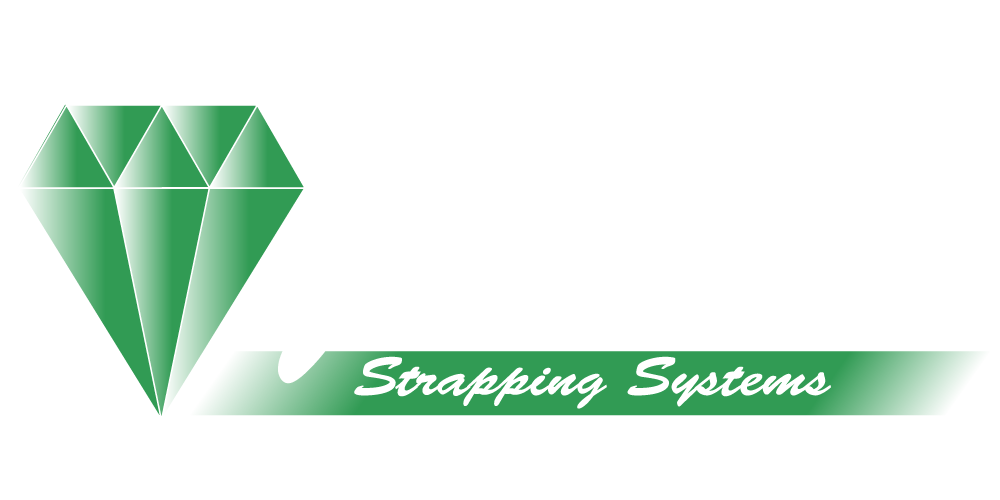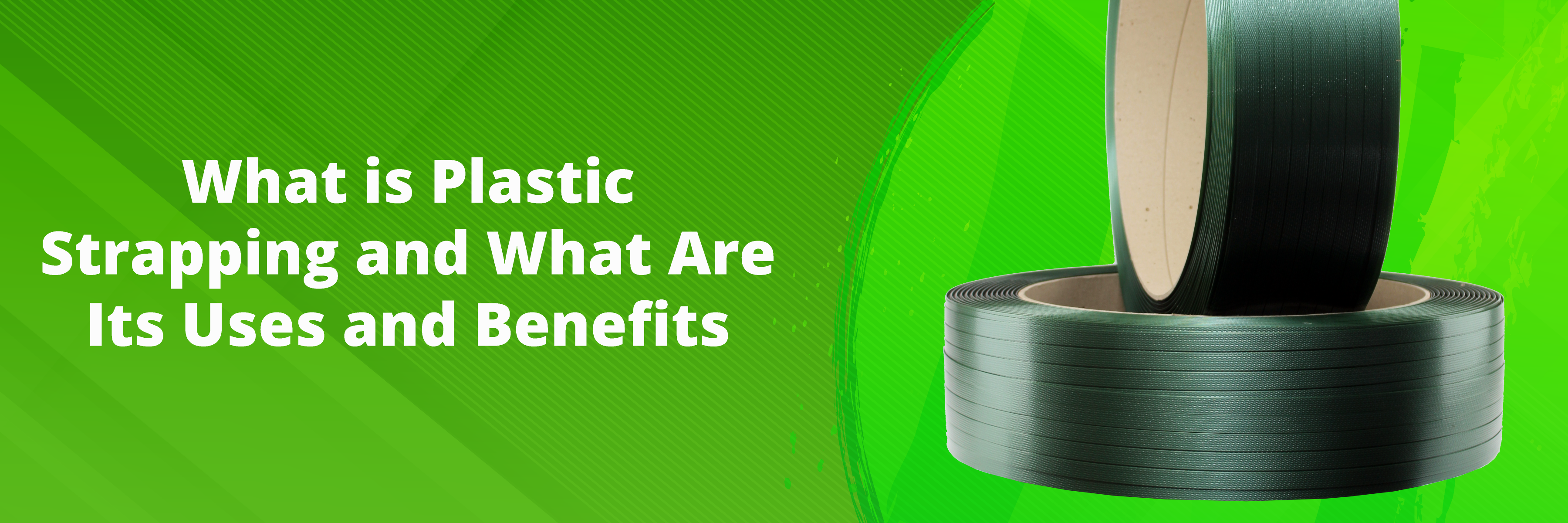Plastic strapping is an important material used in many industrial and commercial applications. Unlike black painted metal strapping, plastic strapping will not rust or corrode. Whether you need to secure a load of lumber or keep boxes of fragile items safe during shipping, plastic strapping can be an excellent choice.
Below, is a very detailed explanation of how plastic strapping is used, its benefits, and its limitations.
What Are the Different Types of Plastic Strapping?
There are a lot of misconceptions about plastic strapping and how it can be used. Plastic strapping is made of high-quality plastic materials and has a variety of benefits that make it a popular choice for businesses. But it also has its limitations.
To help you better understand whether plastic strapping is right for your cargo needs, here’s a breakdown of the various types of plastic strapping systems, specifically polyester strapping, high recovery nylon strapping, polypropylene strapping, and cord strapping.
Polyester Strapping
Polyester is normally green in colour, but it can also be black. It is commonly used for medium to heavy-duty bundling, tying, and unitizing applications. It has many of the reliable qualities of steel strapping.
There are two main ways to make polyester strapping, through sheet extrusion and single strand extrusion.
Sheet extrusion involves the resin being extruded in a sheet form and then slit to the correct width of strapping required. This method seems to be the method of manufacturing for 9 mm (3/8”) and 12mm (1/2”) polyester strapping. Single strand extrusion, however, is the more common method to make polyester strapping.
Machine-grade and AAR machine-grade polyester normally will have a tensile strength of 60,000 to 65,000 psi. Hand grade/tool grade can vary a lot and will have a tensile strength of 48,000 to 55,000 psi and can be less than that.
Many of the non-North American imported PET (Polyester) strapping is normally lower in tensile strength. This is due to a lower quality of PSI resin used during manufacturing or a high-quality resin used with a lower weight of grams per meter, which results in a much lower average break load of the strapping. It should be also noted that to make North American grade of Polyester strapping requires a very large investment of over $3million Euros in a European production line to get the North American quality we expect . I will point out that you can buy production lines for as little as $200,000 -750,000USD but the product off this line(s) can not normally meet machine grade polyester requirements.
It should be noted that most imported non-North American polyester is normally made to its original country of origin specifications which may not meet North American ASTDM 3950 specifications. Unfortunately, over the last 25 years we see that most offshore imports are well below the normal expectations of North American specifications.
Advantages:
- Lighter per coil but has relatively good break load strengths.
- Non-abrasive
- Will not rust
- Longer length coils. This can save valuable labor with fewer changeovers. (More so in jumbo coils)
- You can use manual tools with it, battery tools, pneumatic tools, and automated systems
- High impact resistance
- Embossed polyester is less likely to split in the cold, than smooth polyester strapping.
- You can get a better seal joint with embossed polyester over smooth polyester for friction weld joints
Disadvantages:
- The break load for embossed polyester is a little less than smooth polyester
- You have limitations in maximum break loads with all types of polyester
- Not suitable for applications involving heat or very heavy load requirements
- Not suitable for sharp edges that can cut the plastic polyester strapping.
High Recovery Nylon Strapping (HR Nylon)
Invented in the 1960s by DuPont, high recovery nylon strapping is considered the Cadillac of plastic strapping. No other plastic strapping performs like HR Nylon.
Why is it so special? HR Nylon strapping is the only plastic strapping that will always stay tight around your package after you pull it or stretch it.
It works in all tooling designed for plastic strapping and is available in larger widths such as 5/8” and 3/4”, so it is quite versatile and can be used for many applications. It has an elongation of 12% to 25%.
Advantages:
- The bands stay tight, so if you have a product where the load shrinks over time, or if your load shifts, then HR Nylon solves this problem.
- HR nylon will also shrink around your package if you pulled 50% plus of the strap’s break load.
- Takes less force to engage the properties than polyester strapping which is important in certain applications
- Longest UVI resistance of all plastic strapping
Disadvantages:
- It costs more than polyester strapping and polypropylene plastic strapping
- Same other disadvantages as polyester strapping listed above.
Polypropylene Strapping
PP strapping was one of the first types of plastic strapping in use and it dates to the late 1950s and early 1960s.
Polypropylene strapping is normally used for light packaging containment and in automatic strapping machines. It is the product of choice to strap around boxes and in situations where you need 700 lb. (317kg) load force or less.
There are many different puts ups for polypropylene strapping ranging from 5 mm (1/4″) wide to 16 mm (5/8″) wide. The most common, however, is 9 mm (3/8″) and 12 mm (1/2″). Polypropylene strapping is often available in white, black, and yellow and has an elongation range of 7% to 35%.
Advantages:
- More affordable than Polyester and HR Nylon
- High elongation with low break loads in lbs. force
- It can withstand wear and tear
- Non-corrosive and will not erode over time
Disadvantages:
- Poor resistance to the sun’s UVI
- Low retained tension, and low break loads, along with very high elongations
Cord Strapping
There are three subcategories of cord strapping: bonded cord, woven cord, and composite cord strapping.
Bonded cord strapping is produced by combining high tensile polyester yarns with hot glue. It doesn’t have the cross weave like woven poly cord strapping does, but instead, it has polyester filaments that are glued together. Bonded cord strapping is used heavily in the agriculture industry, bailing industry, and recycling where you do not want to use steel strapping in case of contamination on aluminum cans etc. Bonded strapping has an elongation between 9% and 15%.
Woven cord strapping can be used in bundling light to medium/heavy loads for most industries. General purpose woven cord is ideal for hand-tie applications and various industries, including agriculture, nursery, landscaping, automotive, marine, printing, light building products, and for baling corrugated and plastic for recycling. Woven cord strapping has an elongation between 9% and 15%.
Lastly, Composite cord strapping is made from polyester fibers coated with clear polypropylene. The polypropylene coating provides added water resistance protection and improved bundling properties when threading the strapping under pallets and through metal buckles.
Advantages:
- Bonded cord strapping is a cost-effective item in some applications.
- It does not rust
- Bonded cord can be tied into a knot without tools
- Less likely to damage the edges/corners on lumber.
Disadvantages:
- Recycling is difficult because they are comprised of different types of plastic resins
- It takes a lot longer to apply than steel strapping, PET, or HR nylon strapping.
- Higher labor costs to apply per bundle. Cannot automate cord strapping.
- If bonded strapping is left outside for a long time the UVI in the sun will break down the glue bonding the polyester fibers together changing the strapping holding force.
- More expensive per foot as compared to steel and polyester plastic strapping of similar break load
- If left on the ground, it can also cause problems for the power fork trucks.
- Wire buckles used in all cord strapping applications are very expensive and are labor intensive to thread, more so in cold winter applications that requires you to remove gloves to perform the threading of the wire buckle.
- Composite strapping is adversely affected by UVI and the polypropylene coating breaks down quickly when exposed to UVI from the sun.
What Are the Industrial Uses of Plastic Strapping?
Plastic strapping can be used in a variety of industries and applications. Knowing when to use each type of strapping depends largely on the type of load you are strapping, the weight, available time to complete application, how it is handled, and how it is transported, plus various other factors.
Some of the main advantages of using plastic strapping include:
- Good performance
- Easy to discard
- Stretchable
- Moisture resistant on PP , PET , HR Nylon, and Composite cord
- Polyester and HR Nylon are UV-resistant
- Can be cost-effective on some types of applications, you must be careful which one you choose as all have advantages and disadvantages.
- Rustproof
- High impact resistance on some types
As a rule of thumb, polyester or HR Nylon can be used on loads that are less than 5,000 lbs. Loads do not involve heat. HR Nylon is recommended if your load shrinks or shifts in transit and is less than 5,000 lbs.
Polypropylene strapping is recommended for light-duty applications
Cord strapping depends on the application. You must have the time to apply it as it takes 2 to 4 times longer to apply cord strapping.
If the product is over 5000 lbs., you should always use steel strapping. If any heat is involved or the product is sharp/has corners or 90-degree angles that might cut the other types of strapping, choose steel strapping.
Choose JEM Plastic Strapping, a Top Manufacturer in Canada
JEM Strapping Systems is the only Canadian manufacturer of steel strapping and one of the best suppliers of plastic strapping and non-metallic strapping in Canada. We carry a full line of cargo control products, ranging from steel strapping, plastic strapping, non-metallic strapping, and stretch films and tapes.
Our mission is to educate consumers on how to choose the correct strapping for their needs—regardless of whether it is something we make or buy and resell. Our concentration is on high-quality strapping, tools, seals, dispensers, and tool parts, and we abide by all ASTM guidelines. Contact us today to learn more about our plastic strapping systems or to purchase nylon strapping, polye

